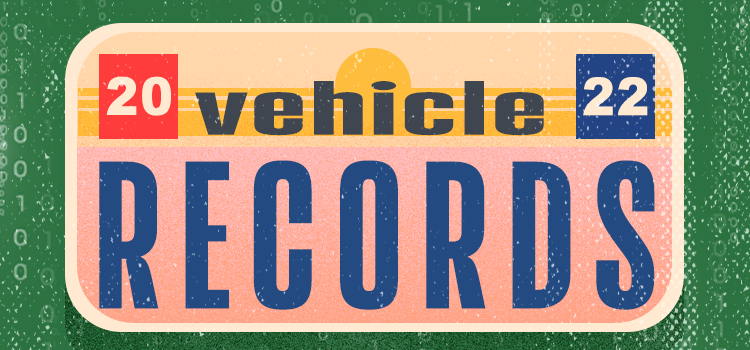October 21, 2021
Disrupting Crime with Vehicle Records

Steve Adams
Product Marketing Manager
There are 287 million vehicles registered on the road in the U.S., equating to roughly 872 cars per 1000 people. Vehicles are intrinsically linked to our way of life and are rarely found far from their owners, with infrastructure designed around their heavy use. Therefore, identifying the vehicle that the subject of an investigation owns, has access to, or is in possession of, can provide valuable insight into their current location.
The use of roads by criminals ranges from smaller-scale crimes, like the theft of vehicles or body parts, to international organized crime, like trafficking and smuggling. Searching vehicle records enables Law Enforcement Officers to disrupt crime, apprehend offenders, and assist the public. Vehicle records can facilitate; surveillance, vehicle searches, locating missing persons and offenders, tracking stolen vehicles, and preventing physical attacks.
Surveillance
When necessary and proportional, Law Enforcement Officers can conduct covert surveillance on the subjects of their investigations. Observing the movements and activities of criminals can support the prevention or detection of crime, enabling alleged criminal activity to be quickly disrupted. Determining a vehicle that the subject has access to means that investigators can observe persons of interest from a distance and follow them without identifying them in person. Vehicle identification also means that a person of interest’s vehicle can be located whilst parked, meaning that it can be observed until the subject returns.
Searching Vehicles
Criminals use vehicles to transport illegal items, including weapons, drugs, and stolen items. When conducting a property search, Law Enforcement Officers may search a subject’s vehicle for items that are relevant to their investigation, in addition to searching residential premises. Identifying a suspect’s vehicle using vehicle records can enable Officers to locate a suspect’s vehicle. Identifying a suspect’s vehicle means that it can immediately be searched, minimizing the risk that any contents are removed.
Locating Missing Persons and Suspects
Law Enforcement Officers may need to locate offenders or victims. Automatic Number Plate Recognition (ANPR) systems scan vehicle registration marks (VRMs), checking them against information stored in vehicle databases to identify vehicles of interest to Law Enforcement, such as stolen cars, those involved in crimes, or vulnerable missing persons. When ANPR devices recognize a vehicle with predetermined flags, it can enable Law Enforcement Officers to locate the vehicle and target it for interception or further inquiries. Similarly, all-points bulletins (APBs) can be issued to officers to stop vehicles. Identifying vehicles that a suspect or missing person may have access to can enables those vehicles to be flagged, assisting the disruption, prevention, and detection of criminal activity.
Insurance Fraud
During Auto Insurance Claim Investigation, insurance companies may investigate the coverage, the claim itself, and the background of an insured party. In the case of two-vehicle and multi-vehicle accidents, insurance companies may seek to determine that the two parties had no prior relationship before the collision. Identifying the owners of vehicles and their co-residents determines who may have access to them, potentially identifying individuals defrauding the insurance company. Insurance companies may also seek vehicle data to discover high-value leases and loans that an insured party may hold. High-value leases can influence a decision to commit a crime or evidence an under-declaration of property value to reduce monthly payments. Vehicle data facilitates insurance investigators in establishing the circumstances during fraudulent claims, reducing the extent of insurance fraud.
Vehicle Tracking
In 2020, over 870,000 vehicles in the U.S. were stolen, worth a total value of over $6 billion. Stolen vehicles may be used during a crime or trafficked to finance further criminality, including drug trafficking, arms dealing, people smuggling, and international terrorism. Organized criminal groups have identified the acquisition, shipment, and trade of stolen vehicles as a low-risk way to make profits and finance further criminality. Vehicle theft is difficult to investigate as vehicles are frequently stolen overnight, in darkness, and without witnesses. Physical evidence is unlikely to remain at the crime scene, resulting in difficulty linking offenses to offenders and identifying the methods used. Vehicle tracking systems enable Investigators or owners to locate where a stolen vehicle is or where it was before device removal. Identifying stolen vehicles through vehicle data means that action can be taken immediately, without waiting for a victim to identify the relevant details when injured or in shock. Vehicle records enable vehicles to be tracked before devices are removed or deactivated, increasing the opportunity to apprehend the offender.
Physical and Executive Threats
Global Security teams are responsible for protecting a business’s assets and people. When a Security team identifies a potential threat actor then they will seek to locate them. In the event of a threatening social media post, identifying the individual responsible and the vehicle that they drive can enable on-site security personnel to establish a visual description of the target. Vehicle identification means Security can stop threat actors outside company buildings, where they pose less risk to the business.
Sourcing Vehicle Records
Vehicle records are a brand new data source recently introduced on the Skopenow platform. Skopenow’s vehicle records enable Investigators to identify vehicles associated with a subject or the subject’s home address, including owned and leased vehicles.
Searching for a subject within the Skopenow platform lists all vehicles they can potentially access, including those they own and those belonging to co-residents. Investigators can also perform reverse VIN searches to identify all residents at the registered address of the vehicle.
Skopenow’s vehicle data comprises records of vehicles in the U.S. and Canada, including the VIN, Make, Model, Year, Date Acquired, and Vehicle Body Type. This information enables investigators to identify their subject’s vehicles, facilitating subject identification, surveillance, and vehicle searches.
To determine the value of the Skopenow platform to your organization and utilize our new vehicle data during your investigations, please reach out to sales@skopenow.com or visit www.skopenow.com/demo to schedule a demo and activate a 7-day free trial.


